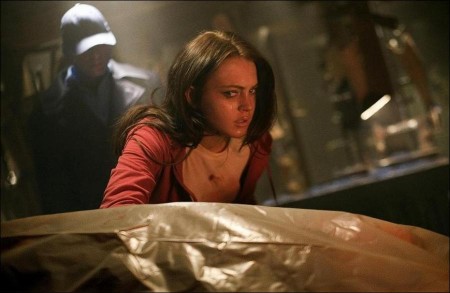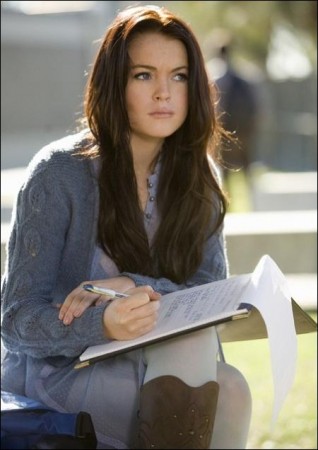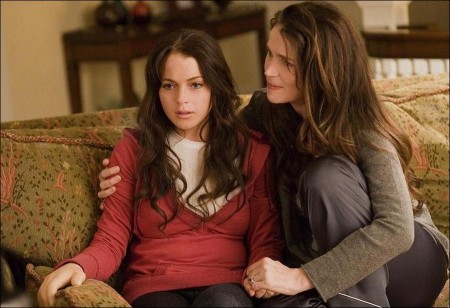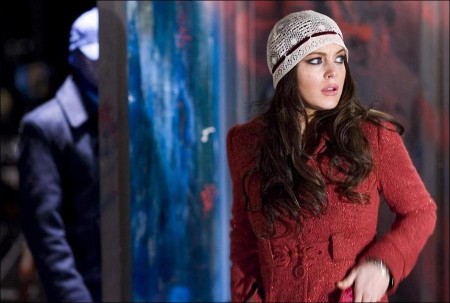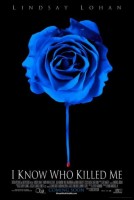Tagline: If you think you know the secret… Think twice.
An idyllic small town is rocked when Aubrey Fleming (Lindsay Lohan), a bright and promising young college student is abducted and tortured by a sadistic serial killer. When she manages to escape, the traumatized young woman who regains consciousness in the hospital insists that she is not who they think she is – and that the real Aubrey is still in mortal danger.
A taut and stylish psychological thriller with a captivating riddle at its center, I Know Who Killed Me explores the dark side of identity, family and obsession.
The Story
The quiet suburb of New Salem is being terrorized by a brutal serial killer who abducts and tortures young women, holding them captive for weeks before murdering them. Aubrey Fleming, a talented pianist and aspiring writer, appears to be his latest victim when she disappears without a trace during a night out with friends. As the days tick by, the special FBI Task Force convened to track the killer begins to lose hope of finding her before it’s too late.
Then, late one night, a driver discovers the young woman by the side of a deserted road, disheveled and critically injured, pleading for help. The girl is rushed to the hospital, where Aubrey’s distraught parents, Susan (Julia Ormond) and Daniel (Neal McDonough), wait by her side as she slips in and out of consciousness. When she is finally able to speak, she shocks everyone by claiming to be a down-on-her luck stripper named Dakota Moss who has never heard of Aubrey Fleming.
Convinced Aubrey is suffering from post traumatic stress disorder, her doctors, parents and law enforcement officials can only wait for rest and therapy to restore her memory. But after returning to her parents’ suburban home, she continues to insist that she is not who they think she is, despite bearing bizarre wounds identical to those of the serial killer’s previous victims. The FBI agents are further mystified when they search Aubrey’s computer and discover a short story about a girl with an alter ego named Dakota.
When Dakota begins to suspect she may be Aubrey’s identical twin sister, Susan shows her a video of her pregnancy ultrasound clearly revealing there was only one fetus in her womb. Confused and terrified, Dakota starts seeing visions of a menacing figure slowly butchering his captive. Convinced that time is running out both for Aubrey and herself, Dakota confronts Daniel with a shocking truth that leads them on a frantic hunt for the killer.
The Making of I Know Who Killed Me
When producer Frank Mancuso, Jr. first came across the script for I Know Who Killed Me, he was instantly intrigued by its unique premise. After almost 30 years in the film business working on projects ranging from the Friday the 13th franchise to the international espionage film Ronin starring Robert de Niro, Mancuso has learned to trust his instincts when he selects a property. “One of the first criteria I employ is ‘Do I want to see this movie?’ ” Mancuso says. “When I first read this screenplay, I saw a story that I hadn’t seen before. The characters were richly drawn. The scenario was compelling. It really sucked me in.”
As Mancuso began looking for a director for the project, one of the first names to come up was Chris Sivertson. A relative newcomer to features, Sivertson’s debut film The Lost had generated controversy and acclaim on the film festival circuit with its frank depiction of a charismatic sociopath. “I was knocked out by it,” says the producer. “He made the film for very little money. As soon as I saw it I knew we had found our director.”
At his first meeting with Sivertson, Mancuso was equally impressed by the director’s vision for I Know Who Killed Me. “I had this immediate sense that this guy really wanted to make the same movie that I did,” Mancuso recalls. “He was sucked in, in the same way I was. Chris had all the right sort of instincts that were going to elevate the movie and take it beyond a genre movie, beyond a horror film.”
As evidenced by his debut feature, Sivertson is attracted to material that explores the darker side of human nature. “Too often thrillers are populated by twodimensional characters,” he says. “This is one of those unique scripts where the characters are truly pushing the plot forward, which is the main thing I’m looking for when reading a script. Even before I was halfway through, this character Aubrey, who I found myself caring about, all of a sudden says she’s Dakota. And Dakota turns out to be one of the most fascinating characters I’ve ever seen in a script.
In stressful situations the brain – understandably – finds ways to cope with the trauma being inflicted on the body. – Dr. Summerly
As the filmmakers began casting the film’s central, dual role of Aubrey Fleming and Dakota Moss, they were faced with a number of intriguing questions, recalls Mancuso. “Did we want to go with somebody well known? Did we want to discover somebody? Should we populate the movie with competent, strong performances, or were we looking for stars? We had the freedom to take it in any direction we wanted, so we asked ourselves: Who would make people stand up and take notice of this movie?
“Lindsay Lohan is certainly a celebrity, but what’s interesting to me is the quality of the work she’s done up to this point,” he says. “Unlike a lot of people who have attained that status at her age, she really has the goods.”
Lohan, who has been acting since she was a child, remains at the forefront of the current crop of celebrated young actresses. Ironically, her movie career launched with a film in which she played two complementary characters: the twin sisters at the center of the Disney hit movie The Parent Trap. Nine years later, she is eager to make the transition from starlet to leading lady.
Director Sivertson believes the strong parallels between Lohan’s real life and the characters she is playing give her performance an authenticity that would be difficult to plan for. “The movie is about a girl who is at a point in her life where she’s leaving her childhood behind and becoming an adult,” he says. “The more I got to know Lindsay, the more it just seemed natural that she came up doing one thing in her childhood and now’s the time to move beyond that and grow up on camera.
For her part, Lohan was sold on the project before she even finished the script, despite – or perhaps because of the film’s edgy material. “I e-mailed them after I had read just a few scenes and said, I’ll do it,” says the actress. “One of the scenes I read was the stripping scene. Initially, I thought, can’t they rewrite some of that? But in the end it was part of what really interested me. The second I said I couldn’t do certain things, I thought, okay, I have to do it.”
Lohan was a fan of Sivertson’s work before signing on and calls The Lost one of her top five favorite films. She was delighted to find that she and the director were very much in tune in terms of their ideas about the characters. “For me to be able to be doing the things that I’ve done in this movie, I needed a director I was on the same wavelength with. I had my first love scene. I wouldn’t even call it a love scene, it’s a sex scene.”
Sivertson says Lohan saw the film as an opportunity to grow as an actress. “We talked about it in detail and I could sense in her a mixture of nervousness and also excitement about doing it, because it was so different from her previous roles,” the director continues. “She’s a pretty bold person in reality, so to see her bring that to the screen was great.
Some of Sivertson’s directorial techniques reminded Lohan of legendary director Robert Altman, with whom she had worked on The Prairie Home Companion, his final film. “He will sometimes keep rolling after the scene is done and just see what happens, and I’ll start improvising. He’s always willing for me to bring any ideas and thoughts that I have.
Sivertson is effusive in his praise for Lohan. “She’s got an incredible amount of raw talent and what she does on camera seems almost effortless. It’s not, of course; she works really hard at it, but she’s just got a very natural way of working. She’s not a method actress who stays in the moment between each take. But as soon as we were rolling she was right there. And she was very easy to direct because I could tell her very simple things without having to dress it up in any kind of fancy language and she just understood it instantly and was able to build upon it.
Lohan brought a lot of ideas to the project, says Sivertson, including thoughts on how to portray the two very different roles of Aubrey and Dakota. But the director was particularly impressed by her technique and her professionalism: “After three takes she invariably nailed it, which was great given our fast schedule. It was refreshing to work with an actress who just kind of just did it, did it great and then wanted to move on.”
Mancuso also is enthusiastic in his assessment of the film’s star. “It’s very hard sometimes to understand what makes an actor great,” says the producer. “Lindsay’s gift is to be able to inhabit a character and to speak on behalf of that character from a place that feels completely genuine. The natural way that she’s embraced this character is really compelling. A lot of this stuff comes with maturity and while she’s been an actress for a while, she’s still very young. There will be an increasing balance to her life as it progresses. But right now, I’m sure it’s pretty crazy to be Lindsay Lohan.”
Although Lohan has been dancing most of her life, Dakota’s pole dancing scenes presented a new physical challenge. She turned to Sheila Kelley’s S-Factor classes to prepare. Kelley, an actress who appeared in the film Dancing at the Blue Iguana, developed the popular program by combining elements of yoga, ballet, striptease and pole dancing. “It’s really hard getting on those poles,” says Lohan.
“It’s all upper body strength. There were these women that were upside down, sliding down headfirst, and then flipping over, and then going back up. I thought, I can’t really do that.”
The lessons paid off. “I couldn’t believe I was dancing the way I was,” Lohan says. “I watched the footage, and I was just, like, oh my God. But it was fun. I’m actually going to keep up with the lessons when I wrap, just because it makes me feel good.”
Once Lohan committed to the project, the filmmakers began to put together a cast that could match their young star’s intensity. “Once we got Lindsay, we were thrilled, but we didn’t just say ‘Okay, we got her, now we can throw just anybody in the roles,’” says Mancuso. “It’s an ensemble-oriented film: The parents, the boyfriend — it all matters in the movie. We were able to get actors like Julia Ormond, Neal McDonough and Brian Geraghty in part because it was going to be a Lindsay Lohan movie, and she’s great.”
For the role of Susan Fleming, Aubrey’s distracted but loving mother, they cast Julia Ormond. Ormond, who has built a reputation as a distinguished actress with a series of finely crafted performances in films like Legends of the Fall, Sabrina and First Knight, admits she has a weakness for thrillers. “What I really liked about this script was I felt it didn’t fall into the usual traps and clichés of these kinds of stories,’
the actress says. “I thought it was clever. It kept me guessing. It was unpredictable.” The family component was central for the actress, who has a two-year-old daughter. “The Fleming household, from the outside, is fulfilling the American dream, when they’re suddenly thrown into this situation that exposes their flaws. For me, what was especially interesting in terms of the mother and daughter is that my character has to confess to the police officers that she didn’t even look at Aubrey when she last left the house.”
“At the end of the movie, the dysfunctionalism within their relationship is about a secret,” Ormond continues, “And that attacks and erodes the trust in the relationship. It erodes the cohesiveness of a relationship and that’s what you see.”
Lohan and Ormand clicked on a level beyond the words on the page. “We had certain scenes where I didn’t plan on getting upset, but we would just have these looks,” says Lohan. “She’s so amazing and gives so much.”
The director attests to the unspoken communication going on between the two. “In one crucial scene, Susan shows Aubrey/Dakota the ultrasound of her as a baby to convince her that she is really her one and only daughter. It’s just really powerful and it’s not about the dialog. Character-wise, they’re both in this vulnerable place and it just comes together.”
For Daniel Fleming, Aubrey’s conflicted father, the filmmakers were looking for an actor with a strong physical presence that could play against type. They decided on Neal McDonough, an ex-boxer best known for playing tough guys in films like the recent thriller The Hitcher and Clint Eastwood’s World War II epic, Flags of Our Fathers. “I thought it would be interesting to see somebody like Neal play Daniel, because he’s really a tortured soul,” says Sivertson. “He’s harbored a very big secret for a very long time…”
McDonough saw an opportunity to create a complex character in an impossible situation. “I gravitate toward character-driven pieces,” he says. “I Know Who Killed Me is a thriller that incorporates a lot of things, including a really interesting story.”
“It has so many layers, which isn’t typical of thriller-type films,” McDonough continues. “It’s really challenging to play a character that has had such an anvil of guilt on his shoulders for over two decades, and to finally have it fall off his shoulders. Daniel is a very successful attorney, but he’s had to harbor a secret for the last nineteen years. He finally lets the secret out, because he has no choice. His whole life and his wife’s whole life come under the microscope.”
McDonough echoes his co-star’s sentiments about Sivertson’s openness to collaboration. “The best directors are the ones that really have a vision and a passion for their project, but can listen when someone else comes up with a great idea. With Chris, there’s always a conversation going on about the truth of the character and what’s best for the film. By being like that, he puts the whole crew and the actors at ease. And he’s pulled some really fantastic work out of everyone. Without giving away too much, he went through painstaking detail and research to make sure that this film is different from anything else you’ll see out there.”
Brian Geraghty, who appeared in Jarhead with Jake Gyllenhaal and The Guardian opposite Kevin Costner, completed the core cast when he signed on to play Aubrey’s boyfriend, Jerrod.
Geraghty and Lohan had already appeared together in Bobby, the ensemble drama directed by Emilio Estevez and she relished the opportunity to work with the young actor again. “He’s wonderful, really talented, and he’s very funny, even in this movie.”
Sivertson observes that the fact that Jerrod is a low key character actually made Geraghty’s tougher. “This movie is full of colorful characters, whereas Jerrod is an understated guy who is usually reacting to things rather than causing them to happen. It’s a very hard thing for an actor to pull off, but he really committed to everything Jerrod does and it makes the movie work so much better.”
* * *
I could handle creepy guys. This guy was different. – Dakota Moss
According to writer Jeffrey Hammond, the inspiration for I Know Who Killed Me’s complex and unsettling script came from a variety of sources, including incidents he remembered hearing about as a child as well as more recent first-hand experiences.
For instance, he says the idea for the glass weapons used by the Blue Man came to him when the script was almost complete. “I happened to be running to catch a bus from the airport on the way back from Mexico and I was carrying two bottles of tequila. I fell and heard the bottles break and thought, there goes eighty dollars worth of tequila. Then I stood up and there was blood pouring down my arm from the glass that had cut all the way through my jacket into my arm without me even realizing it. So after I spent an hour in the emergency room at the Denver airport I immediately rushed home and incorporated the glass weapons into the script.”
Hammond says the character of the serial killer was created to heighten both the suspense and horror impact of the film. “I needed to figure out a way to disguise him as much as possible throughout the movie so the audience doesn’t figure out who he is — which is always a challenge because people like to figure out those things. So I wanted him to be unrecognizable as one of the characters in the film but also to be very creepy looking.
From the first time he read the script, Chris Sivertson had a strong idea of how he wanted I Know Who Killed Me to look. His plan was to differentiate Aubrey and Dakota by dividing the movie into red and blue sections. “In the first meeting, Chris said that everything Dakota does is going to be red, from her stockings to her lips to everything else,” says Mancuso. “Aubrey’s scenes are in different shades of blue. It helps the audience know who they’re looking at. It also helps the audience inform their emotional reactions to whatever is going on the screen.”
Sivertson explains: “I’m a big fan of color in general. In movies, I like to use color as a thematic tool because it has such a strong affect on our brains. The goal isn’t that the audience will leave the theater talking about how this color meant this or that color meant that. It’s intended to be a subconscious clue to the audience that a change is taking place.”
As an example, the director notes that after Lohan’s character is first discovered by the side of the road and brought to the hospital, she is wearing a blue gown and lying on blue sheets. But as she begins to insist she is Dakota, not Aubrey, the blue begins to disappear and reds begin creeping in. By the time she gets out of the hospital she is dressed almost entirely in red.
For production designer Jerry Fleming, Sivertson’s vision was carte blanche to create a richly detailed secret world. “Chris is definitely one of the most creative directors I’ve ever worked with. He always has a sparkle in his eyes, and it’s because there is always something in his mind. He really cares about the characters and the script and the detail.”
Having one actor play two roles offered logistical challenges for the production crew, recalls Sivertson. “With a great actress like Lindsay it’s not really an issue from an acting standpoint, because she can go between the two characters so naturally. But on a tight schedule, something as simple as changing wardrobe and makeup from one character to the other when you’re in a location where you have to get all your shots by the end of the day can be difficult.”
The action in I Know Who Killed Me moves back and forth through diverse environments including Aubrey’s suburban home, Dakota’s strip club dressing room and the terrifying basement workshop of the serial killer. Fleming was especially excited by the challenge of creating visual clues to the dual personalities and weaving all the hidden details into the sets. “I put as many clues as I could in the film, without being too obvious, which makes it more fun to watch. Everything you need to know about the movie is visually woven through it.
Fleming created hints about the identity of the serial killer and placed them throughout the film. “In Aubrey’s room and in Aubrey’s house, we have marionettes and we have glass. We did a painting in the Fleming house in the living room that contains all the designs of the instruments that the killer uses, so in one shot you have all the information you need about the killer and his method. It’s all in one frame.”
The production designer imbued each set with revealing details for sharpeyed audiences. “The cellar was the first set that grabbed me when I was reading the script,” he says. “It was the densest, most fun set in the whole film. This cellar is the workshop of a true Renaissance man; he’s a master of everything. He’s a musician, he’s a glass worker, a metal maker; he can weld a coffin.”
The strip club dressing room gave Fleming a chance to pay tribute to an early mentor. “I wanted to use mirrors on all the walls. The Lady from Shanghai, an Orson Welles film, ended in this room full of mirrors, and it was just so brilliant, so cinematic. The director I got my start with, Robert Altman, always loved reflections in mirrors and glass. It was kind of like an homage to him that I got to do a set full of mirrors with reflections.”
Mancuso praises the way Sivertson and Fleming collaborated to create visual cues that reflect the minds and lives of the characters. “They absolutely were in sync with ways to populate the movie with iconography that most people would glance at, and think, that’s a nice stained-glass window,” he says. “But if you take a step back, you see what it really is. They’ve found ways in every set to fill it with imagery and colors that will guide the audience through the emotional landscape of the movie.”
* * *
Maybe that’s why ghosts are restless. Because there’s nothing left of what they were except pain. – Dakota Moss
I Know Who Killed Me is shot in HD using the Genesis system, which was previously used to shoot Mel Gibson’s historical epic Apocalypto, a film recognized by the American Society of Cinematographers for Outstanding Achievement. Mancuso was the chief proponent of using HD. “I thought, because there was going to be significant digital work to do in postproduction relating to visual effects, it would be important,” explains the producer. “I also felt like the aesthetic nature of this new system was fantastic. It has eliminated a lot of the early hindrances with HD in terms of depth of field and cumbersome cameras and so on.
And the ability to maneuver the image in postproduction with both color and texture is extraordinary. I really felt like this movie wanted to feel modern and of the moment. This system represents the far end of what the moment is.”
Sivertson was initially reluctant to commit to shooting in HD, but a series of tests demonstrated to him and cinematographer John R. Leonetti that the high definition camera would expand their opportunities for creativity in postproduction.
“I’m a big lover of old cinema, and I shot my first movie on super-35 and had a great experience working with film,” says the director. “I was really interested in using strong colors in the film, really creating a very specific color palette. And one of my fears about HD was that the colors just wouldn’t be rich enough because rather than making a thriller that had a dark monochromatic film noir look, I wanted to do the opposite and have this real bright, colorful look.”
As it turned out, HD actually offered the filmmakers the ability to enhance the color palette, says Mancuso. “This photography allowed us to make the blues more blue, the reds more red and to deal with textures. There are ways that you can paint the film after it’s been shot that afford you a unique opportunity as you’re going through post to revisualize or re-emphasize certain parts.”
But before agreeing to use HD, Sivertson and Leonetti put the Genesis system through its paces. “We didn’t just shoot the tests and look at them on an HD monitor and be satisfied with that,” he says. “We actually brought it out to film each time. Because, although there are a lot of digital projectors in cinemas these days, for the most part, people are going to be going to the movies and watching a film print. So it was really important to see how the HD translated to film. I was just really impressed by results of all these tests.
Once production began, Sivertson says he discovered there were other advantages to shooting in HD. “Lindsay, for example, really likes to just keep going once she gets in a moment. So a lot of times I would just keep the camera running and we would just do several takes in a row. If we were shooting on film we would have had to reload the camera. So we got a lot of cool stuff that we might not have gotten on film if I would have had to stop rolling.
* * *
Why does he want to kill me? Who am I to him? Who am I? – Dakota Moss
Mancuso is looking forward to seeing the film with a paying audience to find out which characters they connect with and what they get from the story. “The journeys that the characters go on can take you a number of ways. The story is told, I think, from a strong enough point of view that the audience might not immediately know where this movie is going.”
Wherever it’s going, says Neal McDonough, it doesn’t slow down on its way there. “It’s relentless It’s just constantly moving forward and it’s one of those films where literally you’ll be sitting at the edge of your seat just, just wondering what’s going to happen next and screaming at the screen ‘Don’t go in there! Don’t do that!’”
To Lohan, I Know Who Killed Me is nothing less than a great thriller. “I think it will be The Silence of the Lambs for my generation,” says Lohan. “It’s not too often that people my age come across a really great psychological thriller. This is that movie for me. It really will have people wondering the whole time and on the edge of their seats, which I think is really cool to be a part of, because I love this kind of movie.”
Production notes provided by Columbia Pictures.
I Know Who Killed Me
Starring: Lindsay Lohan, Julia Ormond, Neal McDonough, Brian Geraghty, Garcelle Beauvais-Nilon, Gregory Itzin
Directed by: Chris Sivertson
Screenplay by: Jeff Hammond
Release Date: July 27th, 2007
MPAA Rating: R for grisly violence including torture and disturbing gory images, and for sexuality, nudity and language.
Studio: Columbia Pictures
Box Office Totals
Domestic: $7,498,716 (78.3%)
Foreign: $2,074,300 (21.7%)
Total: $9,573,016 (Worldwide)
